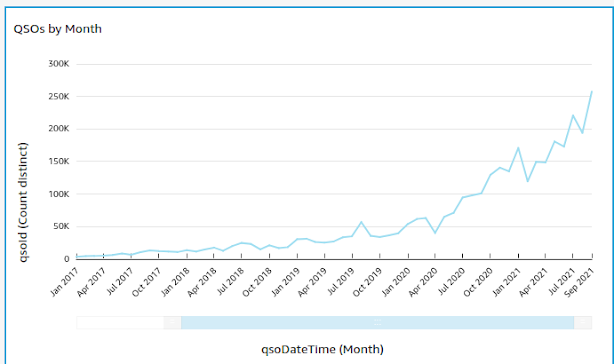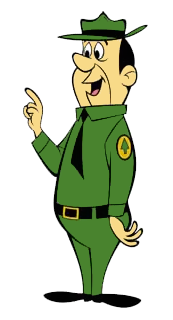Eight Reasons POTA Is the Best Thing Ever to Happen to Amateur Radio Ever
On my first Parks on the Air (POTA) activation, in April of 2021, I logged eighteen contacts. Seven of those were on satellite, which is only slightly better than I do on a typical satellite pass. If it had been an HF-only activation, as many POTA activations are, it would barely have been a success. In September of the same year, just five short months later, I activated Crystal Cove State Park, K-1141. Technically, I activated it twice, since midnight UTC rolled around partway through the afternoon (US Pacific time) that I spent there. On that visit to the park, I logged 104 contacts. I'd like to think that the increased success in completing QSOs can be attributed to the great strides I've made in my skills as an operator. I'd like to think that. More likely is that the activity itself is growing, and with that growth comes ever-increasing opportunities to make contacts.
On-air activity for POTA has spent the last two years growing by leaps and bounds. We hear anecdotal reports on Twitter and on the POTA Facebook group about regional coordinators being inundated with loggings, and about activators working massive pileups. The numbers bear these reports out. Between June of 2019 and September of 2021, there has been a fivefold increase in the number of POTA QSOs logged monthly1.
 |
| Number of logged POTA QSOs |
What's been behind this growth? That's largely a matter of speculation. It would appear that POTA is meeting a need that has, until now, gone largely unmet in amateur radio. More to the point, it's probably a number of needs that POTA is meeting, a particular combination of boxes that POTA is checking that don't all get checked by other activities. Here are some possible drivers of POTA's recent success.
Ease of registering
If you have successfully completed all the steps necessary to register for Logbook of the World—something I would encourage every ham to do—you'll find registering for Parks on the Air to be a breeze. Because the responsibility for logging POTA contacts rests entirely with the activator, you'll find your hunter points waiting for you as soon as your registration is complete.
Robust spotting network
Most contests and QSO parties discourage the use of spotting networks. POTA isn't a contest. Not only is spotting permitted and encouraged, the POTA website itself maintains an easy-to-use spotting page that hunters regularly update. If you're activating using CW or FT8, you'll find that the spotting page integrates with RBNs, so if you're in a remote location where self-spotting isn't possible, there's a good chance the RBNs will find you. All of this makes it relatively easy for hunters and activators to find each other, and more often than not you'll experience the pileup after just a few CQ calls.
Brief, but relaxed exchange
There is no prescribed exchange for POTA contacts. Most activators and hunters are content to exchange signal reports and QTH (the latter usually as a two-letter state or province abbreviation, if it's the US or Canada). This is good news for hams who aren't particularly interested in rag chewing. This can also be good news for anyone just getting started in learning CW; the somewhat predictable rhythm of QSOs means a better chance at solid copy. And although POTA contacts are usually brief, they're not necessarily terse. It's not at all uncommon for a POTA contact to include some combination of GL, FB, or 73, something that can get overlooked in the hurry to log contest QSOs.
Earning awards is easy
Your first award will probably be the Bronze Hunter Award, which you'll receive after hunting ten unique parks. Similarly, there is an award for activating ten unique parks. You can earn awards for activating on one of the four designated Support Your Parks weekends held every year. When trying anything new, it's important to be able to chalk up some early successes. I suspect the opportunity to enjoy early successes is a big reason so many hams are giving POTA a try.
Earning awards is challenging
There are hunter and activator awards extending into the thousands of parks activated or hunted. There are awards for operating portable. There are awards for hunting or activating all 50 US states, awards for working all listed parks in a particular state, and lots more. Once the early successes are achieved, there are always more challenges around the corner.
Awesome scenery
The state and national parks of this and other countries are some of the most beautiful spots on earth. As an activator, you'll find the excuse to visit some truly unique places—often right in your own back yard—that you might otherwise have overlooked. More than once you'll look up from your rig and marvel at the sights of what has become your shack for the day. If it's not your day to get out of your home shack, hunting can be a chance to become an armchair traveller of sorts. A lot of activators like to post their photos on Twitter or the POTA Facebook group; you may very well get to see the place you worked.
 |
| Chino Hills State Park K-1139 |
 |
| Joshua Tree National Park K-0041 |
Opportunities for DX
From my home QTH in California, Europe is a challenge. As a new-ish ham, I've only logged five contacts with Europe. Four of those contacts were made while doing POTA activations. Hams all over the world, and hams in Europe in particular, enjoy hunting parks, and you stand a good chance of working some DX contacts on your activations. In Europe, Worldwide Flora and Fauna (WWFF), a completely different organization from POTA, but one with similar goals of activating and hunting parks, is quite popular. As a courtesy to hunters all around the world, you might consider submitting your loggings to both organizations.
Outreach
We hear plenty of stories about activators' unpleasant encounters with suspicious passers by, or with rude and officious park rangers. None of those have happened to me yet, and I suspect I'm not in the minority on that. Most fellow park visitors and park rangers that I've seen haven't paid that much attention to me. Those that do have been overwhelmingly friendly and genuinely interested in what I'm doing. Even in the tech-saturated world we find ourselves in, the fact that I'm bouncing my signal off the upper atmosphere or off a tiny CubeSat never fails to impress. As an activator, you have opportunities to talk up POTA, and to be an ambassador for amateur radio.
Conclusion
The growth curve won't stay as steep as it is now forever. At some point we'll see a transition from explosive growth to steady growth. What happens next is anyone's guess. As we've discussed here, POTA appears to have a lot going for it that can ensure it stays around after the excitement of this particular growth phase wears off. In the much longer term, POTA's success will be tied with the overall success of amateur radio. Amateur radio's long-term growth is far from assured, a topic better covered in another blog article, but that link between amateur radio's success and POTA's success could work the other way too. As more antennas (respectfully and unobtrusively) sprout up at parks and enthusiastic activators share what they're doing with curious park visitors, the visibility and the outreach and opportunities to do something fun with radio could well be part of what gets more people involved.
Acknowledgment: I would like to express my gratitude to Vance Martin N3VEM for helping me find the data on POTA's growth.
1. Math geeks will point out that the number of possible QSOs will increase as a function of the factorial of the number of participants. A curve representing a metric like number of registered users or number of activations (for which month-by-month data were not available) can be expected to look somewhat less dramatic than a curve like the one in this article representing number of QSOs. Those math geeks are right. That still leaves us with two takeaways: (1) that at a time when repeaters are falling silent and CQs are going unanswered, POTA is in growth mode, and (2) that probably sometime in the middle to late part of 2020 POTA hit a critical mass where the sheer volume of QSOs started encouraging greater participation, setting up a feedback loop of increased participation driving increased QSOs and increased opportunities for QSOs driving increased participation.


Great write-up. I'm sending this to my club email list, many of whom would rather read a short well-written article than watch a video or, horrors, sit through one of my POTA presentations. de K0BAK
ReplyDelete